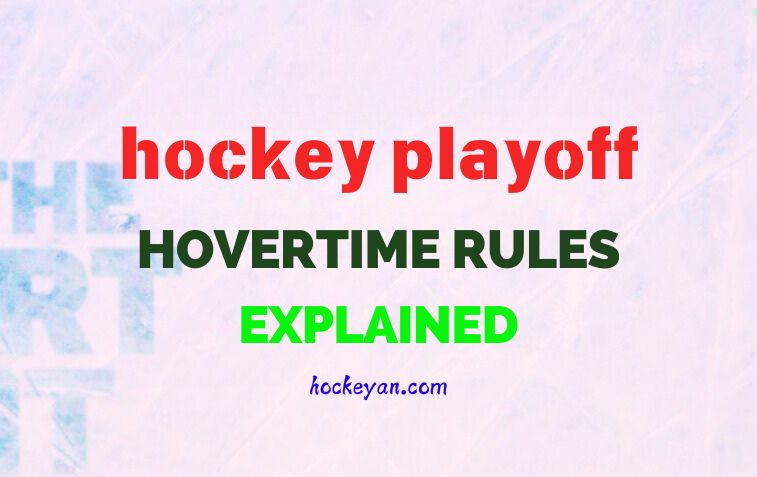In hockey playoff overtime, games are decided by sudden death, meaning the first team to score wins. Overtime periods last 20 minutes each.
Overtime rules for the hockey playoff are crucial for fans and players to understand. The excitement escalates as every moment can determine the game’s outcome. Sudden death over time means the game continues until one team scores. This rule ensures a definitive winner, making each second thrilling.
Teams play five-on-five hockey during these periods. The intensity is palpable, and strategies become even more critical. Coaches and players need to stay sharp and adaptable. The longer format tests endurance and skill. Overtime in playoff hockey is a true test of grit and determination. Fans eagerly watch, knowing any play could be the game-winner.
Credit: www.reddit.com
Introduction To Playoff Overtime
Hockey playoff overtime is thrilling and nerve-wracking. Fans are on the edge of their seats. This section dives into the magic of playoff overtime.
Importance Of Overtime
Playoff overtime adds excitement to hockey. It’s win or go home. Teams give everything they have. The stakes are higher than the regular season.
Winning in overtime boosts team morale. It can change the series. Losing, on the other hand, can be heartbreaking. Every second counts in overtime. Players push their limits, creating unforgettable moments.
Historical Background
Hockey playoff overtime has a rich history. The first overtime game was in 1919. The rules have evolved since then. Early overtime rules were different. The format was not as standardized.
Today, overtime is a sudden-death period. The first team to score wins. This rule was adopted to make the game more exciting and some of the greatest moments in hockey happened in overtime. Wayne Gretzky, Bobby Orr, and many legends have shined in these moments.
| Year | Overtime Rule Change |
|---|---|
| 1919 | First playoff overtime game |
| 1983 | Introduction of sudden death overtime |
| 1999 | Introduction of 4-on-4 overtime |
Regular Season vs. playoff Overtime
Hockey overtime rules change between the regular season and playoffs. These changes affect game strategy and player performance. Understanding these differences helps fans and players alike.
Key Differences
During the regular season, overtime consists of 5 minutes. This period is played with three players on each side. If no team scores, the game goes to a shootout. Each team gets three shots to score.
In the playoffs, overtime rules are different. Overtime periods last 20 minutes. Teams play with five players on each side. The game continues until a team scores. There are no shootouts in playoff overtime.
| Aspect | Regular Season | Playoffs |
|---|---|---|
| Overtime Period Length | 5 minutes | 20 minutes |
| Number of Players | 3 vs 3 | 5 vs 5 |
| Shootouts | Yes | No |
Impact On Game Strategy
These rule differences impact game strategy. In the regular season, teams focus on quick, high-risk plays. They aim to score fast due to the shorter overtime period.
In the playoffs, the strategy changes. Teams play more conservatively. They focus on strong defense and careful offense. This is due to the longer, sudden-death periods. A single mistake can end the game.
Players must manage their energy differently. Regular season overtime is short so that players can give full effort. In the playoffs, players pace themselves to last through potentially multiple 20-minute periods.
Coaches also adjust their tactics. They may use different lineups or shift strategies. In regular season overtime, speed and skill are crucial. In playoffs, experience and endurance become more important.
Format Of Playoff Overtime
The format of playoff overtime in hockey is thrilling and intense. Playoff overtime rules differ from regular season rules. They make the game exciting and fair. Here, we will explore the key aspects of playoff overtime rules.
Sudden Death Format
Playoff overtime uses a sudden-death format. This means the game ends when a team scores a goal. The first team to score wins the game. This rule makes the game very exciting. Fans love the tension and drama of sudden death over time.
Overtime Period Length
The length of each overtime period is 20 minutes. This is the same as a regular period in the game. If no team scores in the first overtime, another 20-minute period begins. This continues until a team scores. There is no limit to the number of overtime periods.
During overtime, teams play with five skaters each. This is different from the regular season, where teams play with three skaters in overtime. This rule helps to keep the game fair and balanced.
| Aspect | Playoff Overtime |
|---|---|
| Format | Sudden Death |
| Period Length | 20 Minutes |
| Skaters | Five per Team |
These rules ensure that playoff overtime is exciting. Fans enjoy the fast-paced action and the uncertainty. Every moment counts in playoff overtime. The stakes are high, and the pressure is immense. This makes for unforgettable hockey moments.
Credit: www.bostonglobe.com
Player And Team Preparation
Preparing for hockey playoff overtime is crucial. It requires both physical and mental readiness. Teams must focus on endurance and mental toughness. These factors are key to success over time.
Training For Endurance
Endurance is vital in playoff overtime. Players train hard to keep their energy levels high. They perform cardiovascular exercises and strength training.
| Exercise | Benefit |
|---|---|
| Running | Improves stamina |
| Weight Lifting | Builds strength |
| Interval Training | Boosts endurance |
Coaches monitor players’ progress. They adjust training as needed. Teams also practice game scenarios. This helps them be ready for any situation.
Mental Readiness
Mental toughness is just as important as physical strength. Players use visualization techniques to stay focused. They imagine different plays and outcomes.
- Positive thinking
- Stress management
- Team support
Coaches provide mental exercises. These exercises help players stay calm and alert. Players also rely on their teammates for support. This helps build a strong team bond.
Strategies In Playoff Overtime
In playoff overtime, teams need special strategies to win. The tension is high, and every second counts. Knowing the right tactics can make all the difference. Here, we discuss key strategies for both offense and defense.
Offensive Tactics
The offense is about scoring that crucial goal. Teams use different tactics to break the opponent’s defense.
- Speed and Agility: Fast skaters can create quick scoring chances.
- Strong Passing: Accurate passes help to keep the puck moving.
- Positioning: Players must be in the right place to take a shot.
- Power Play: Using the extra man advantage effectively.
Effective offensive tactics can wear down the opponent. This increases the chances of scoring in overtime.
Defensive Approaches
Defense is equally important in overtime. Preventing the opponent from scoring is critical.
- Shot Blocking: Players must block as many shots as possible.
- Strong Goaltending: The goalie needs to be alert and ready.
- Clearing the Puck: Quick clears help avoid dangerous situations.
- Stick Checking: Effective stick checks disrupt the opponent’s play.
A good defense can turn the tide in playoff overtime. It allows the team to stay in the game longer.
| Offensive Tactics | Defensive Approaches |
|---|---|
| Speed and Agility | Shot Blocking |
| Strong Passing | Strong Goaltending |
| Positioning | Clearing the Puck |
| Power Play | Stick Checking |
Understanding these strategies helps players stay prepared. In playoff overtime, every move matters. Teams that master these tactics have the edge.
Famous Overtime Moments
Hockey playoff overtime is always thrilling. Some moments stand out in history. These moments include iconic goals and memorable saves. Let’s explore some unforgettable highlights.
Iconic Goals
Many iconic goals have been scored in overtime. These goals are celebrated by fans and players alike.
- Bobby Orr’s Flying Goal (1970): Bobby Orr scored the game-winning goal in the Stanley Cup Finals. He flew through the air after scoring. This moment is one of the most famous in hockey history.
- Brett Hull’s Controversial Goal (1999): Brett Hull scored in triple overtime. This goal won the Stanley Cup for the Dallas Stars. Some say it was controversial because of Hull’s foot in the crease.
- Patrick Kane’s Cup Winner (2010): Patrick Kane scored in overtime to win the Stanley Cup for the Chicago Blackhawks. Many fans didn’t realize the puck was in the net at first.
Memorable Saves
Goalies have made many memorable saves in overtime. These saves have kept their teams alive in crucial games.
- Patrick Roy’s Glove Save (1996): Patrick Roy made an incredible glove save in overtime. This save helped the Colorado Avalanche win the Stanley Cup.
- Braden Holtby’s “The Save” (2018): Braden Holtby made a miraculous stick save in the Stanley Cup Finals. This save helped the Washington Capitals secure their first-ever Cup.
- Dominik Hasek’s Double Overtime Save (1999): Dominik Hasek made a crucial save in double overtime. This save kept the Buffalo Sabres in the game during the Finals.
Rule Changes Over The Years
Hockey playoff overtime rules have evolved significantly over the years. These changes aim to make the game fairer and more exciting. Let’s dive into the key rule changes that have shaped modern hockey over time.
Evolution Of Overtime Rules
Overtime rules in hockey have seen numerous adjustments. Initially, playoff games had unlimited overtime periods. Teams played until someone scored a winning goal.
In the 1980s, the NHL introduced sudden death overtime. The first team to score won the game. This rule made games more thrilling and unpredictable.
The 1990s brought another change. The NHL implemented a five-minute overtime period. If no one scored, the game ended in a tie. This rule aimed to reduce player fatigue and injury risks.
In 2015, the NHL made a significant change. The league introduced 3-on-3 overtime. Fewer players on the ice increased scoring chances. This rule ensured more games ended in overtime rather than shootouts.
Impact On Modern Games
The evolution of overtime rules has greatly impacted modern hockey. The introduction of 3-on-3 overtime has led to more dynamic and exciting play. Fans enjoy the fast-paced action and increased scoring opportunities.
Overtime rule changes have also influenced team strategies. Coaches now emphasize speed and skill during overtime. Teams often use their most agile and talented players to maximize scoring chances.
These changes have also affected player fatigue and injury rates. Shorter, more intense overtime periods reduce the risk of injuries. Players can give their best without worrying about extended play.
Overall, the evolution of overtime rules has made hockey more engaging. Fans enjoy the excitement, teams adapt their strategies, and players benefit from safer conditions.
Fan Experience During Overtime
Hockey playoff overtime brings a unique thrill to fans. The stakes are high. The game intensity reaches new levels. Fans are on the edge of their seats, hearts pounding with every play. This section explores the fan experience over time.
Excitement And Tension
Overtime in hockey playoffs is pure excitement. Every second counts and one mistake could end the game. Fans feel the tension rise as the game progresses. The crowd’s energy is palpable, creating an electric atmosphere. Cheers and gasps fill the arena with each shot on goal.
Key moments over time become unforgettable memories. Fans remember the saves, the near-misses, and the winning goals. These moments are shared stories among fans, binding them together. The emotional rollercoaster of overtime is a unique part of the hockey experience.
Viewing Trends
Overtime games attract more viewers. Fans don’t want to miss a second of the action. TV ratings spike during these crucial moments. Online streaming platforms see increased traffic. Social media buzzes with live updates and reactions.
The viewing experience varies between the home and the arena. At home, fans enjoy replays and commentary. In the arena, the atmosphere is unmatched. The live crowd’s energy enhances the experience. Each viewing option offers a unique way to enjoy the game.
Here’s a quick comparison of viewing trends:
| Aspect | Home Viewing | Arena Viewing |
|---|---|---|
| Access to Replays | Yes | No |
| Commentary | Yes | No |
| Crowd Energy | Low | High |
| Social Interaction | Online | In-person |
Both viewing experiences have their perks. Fans choose based on preference. The shared excitement of overtime keeps everyone engaged.
Conclusion And Future Outlook
Hockey playoff overtime rules have always sparked excitement and debate. As the sport evolves, fans and analysts continually assess current trends and speculate on future changes. This section delves into the present trends and potential adjustments in overtime rules.
Current Trends
In recent years, the NHL has implemented 3-on-3 overtime for regular-season games. This format increases scoring chances and reduces shootouts. The playoffs, however, still use traditional 5-on-5 sudden death overtime. The intensity and drama of playoff overtime are unmatched. Fans cherish the unpredictability and thrill of extended play.
Another trend is the use of technology. Video review plays a crucial role in ensuring fair outcomes. Officials can review goals, offside plays, and goalie interference. This minimizes controversies and maintains the integrity of the game.
Potential Changes
There are discussions about adopting a shorter overtime period before proceeding to a shootout. This aims to reduce player fatigue and injury risks.
Some suggest a hybrid model. This includes a brief 3-on-3 period followed by 4-on-4 play. This could balance scoring opportunities and strategic depth. The idea of a set number of overtime periods also gains traction. If no winner emerges, a shootout might decide the game. This could limit marathon matches and ensure timely conclusions.
Player safety remains a priority. Rule changes might focus on reducing physical strain. Enhanced medical protocols could also be introduced.
| Aspect | Current Trend | Potential Change |
|---|---|---|
| Overtime Format | 5-on-5 sudden death | Hybrid 3-on-3 and 4-on-4 |
| Technology | Video review for goals | Enhanced review systems |
| Player Safety | Traditional protocols | Advanced medical measures |
Hockey’s future overtime rules promise excitement and innovation. The sport’s dedication to fairness and safety ensures thrilling matches for fans worldwide.

Credit: www.usatoday.com
Frequently Asked Questions
What Are The NHL Playoff Overtime Rules?
NHL playoff overtime features 20-minute periods with sudden death. The game ends when a team scores. No shootouts.
Is Overtime In The NHL Playoffs Sudden Death?
Yes, overtime in the NHL playoffs is sudden death. The first team to score wins the game.
What Is The Overtime Rule In The Playoffs?
In the playoffs, overtime rules differ from the regular season. Teams play sudden death. The first team to score wins.
Do They Have Shootouts In The NHL playoffs?
No, the NHL playoffs do not have shootouts. Games are decided by continuous 20-minute overtime periods until a team scores.
Conclusion
Understanding hockey playoff overtime rules can enhance your viewing experience. The thrill of sudden death makes every moment count. Fans and players alike savor the intensity. Stay informed and enjoy the excitement of playoff hockey. For more updates and insights, keep following our blog.






